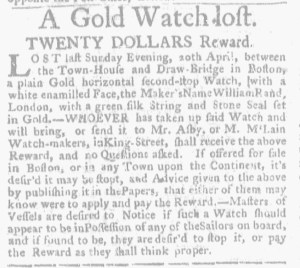What was advertised in a colonial American newspaper 250 years ago this week?

“If offered for sale … it’s desir’d it may be stopt, and Advice given … by publishing it in the Papers.”
Lost and found advertisements regularly appeared in eighteenth-century newspapers. Colonists sought to harness the power of the press in recovering garments, documents, currency, jewelry, and a variety of other items that they misplaced, dropped, or inadvertently left behind. The watchmakers Asby and McLain published an advertisement concerning “A Gold Watch lost” on the evening of April 20, 1771, hoping that readers of the Boston-Gazette, the Massachusetts Gazette and Boston Post-Boy, and the Massachusetts Gazette and Boston Weekly News-Letter would assist in returning it. To that end, they offered “TWENTY DOLLARS Reward.”
The watch went missing “between the Town-House and Draw-Bridge in Boston,” but Asby and McLain widened the search. They realized that whoever might find the watch would not necessarily seek its owner but instead keep it or attempt to sell it. The watchmakers enlisted the assistance of “Master of Vessels,” requesting that they observe their crew to see “if such a Watch should appear to be in Possession of any of the Sailors on board.” Asby and McLain left discipline to captains, advising they either confiscate the watch or pay the reward “as they shall think proper” under the circumstances. Anticipating the possibility that the watch might be “offered for sale in Boston, or in any Town upon the Continent,” the watchmakers asked that the watch “may be stopt” or confiscated and “Advice given … by publishing it in the Papers, that either of them may know w[h]ere to apply and pay the Reward.”
In giving those instructions, Asby and McLain suggested that newspapers would continue to play a role in their search for the watch beyond publishing their own advertisement. They expected readers in Boston and other places to take note, testifying to the dissemination and reach of newspapers in the era of the American Revolution. The watchmakers also suggested that they would scan the newspapers for an advertisement placed in response to their notice. Even though they gave their location and anyone who found or confiscated the watch could communicate with them directly, Asby and McLain depended on the public prints as an alternative.
